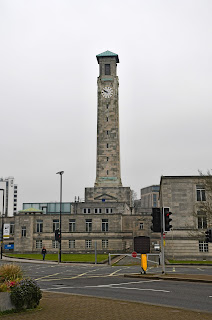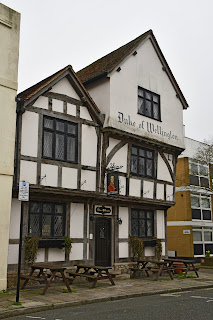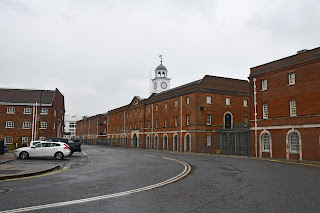Southampton and Portsmouth
Our second UK trip took me and my visiting friend, as well two of my housemates, to Southampton. The weather forecast for the day was grim, and the drizzle that started before noon turned into an intermittently violent downpour that only ended at around four o’clock.
Our first
stop in Southampton was Bargate, the best-preserved part of the town’s
fortifications. Built as a defence against the French, parts of Southampton’s
medieval walls stand to this day. We traced them as we headed towards the sea,
stopping by a few sights of local import, such as the Tudor House, the Juniper
Berry (which is where Jane Austen stayed when she visited Southampton), the old
Merchant’s House, and the Mayflower and Titanic memorials. Southampton’s claim
to fame, of course, is its connection with these two ships, which left the port
town for the New World.
After
taking a regional train to Portsmouth, where the rain started coming down with
utmost ferocity, we ate lunch at a Vietnamese restaurant and sought refuge at
the Cathedral of Saint Thomas of Canterbury. Upon entering, I was immediately
seized by an animated, petite old guide. Picking up on my interest in the
Cathedral’s history, she led me around the entire building, explaining its
bizarre tales. The most memorable story is that in 1450 a group of local
sailors murdered Adam Moleyns, Bishop of Chichester, over their unpaid wages,
and the entire town was excommunicated for fifty-eight years.
An
interesting quirk of the cathedral is a gravestone that says “1741/2”, as the
person buried under it died just as the church was switching from the Julian to
the Gregorian calendar. A pair of stained-glass windows nearby shows the Dunkirk
Evacuation and D-Day, with a nettle above the first and a flower above the
second. As the lady explained, this pairing refers to a line from Shakespeare’s
Henry IV: “Out of this nettle, danger, we pluck this flower, safety.” The
church also houses part of Nelson’s flag, which one can see in a small frame on
one of the southern pillars. Also impressive is a gilt windvane in the shape of
a ship, which used to stand on top of the church until an unlucky fall.
Braving the
ever-inauspicious weather, we wandered down towards the town’s walls, from
which we could see a stormy grey sea and not much else. Spinnaker tower, the
town’s modern landmark that vaguely resembles a sail, was concealed by the fog.
Leaving my housemates at a café on Gunwharf Quays, my friend and I visited the
Historic Dockyard. Since we only had an hour and a half before it closed, we
had to pick one ship to visit; we chose the Mary Rose.
Built under
Henry VIII, the ship was sunk in the sixteenth century and remained at the
bottom of the sea for over four hundred years. In what became the most intensive
and expensive marine excavations to date, the Mary Rose was raised from the
seabed in 1982, after which an entire museum was built around its open carcass.
The remarkable remains are visible from three floors on which the artefacts
found inside are displayed.
By the time we had finished our visit to the Mary Rose, it had stopped raining. However, we had seen what we had wanted to see, and proceeded to take a train to Salisbury.














































Comments
Post a Comment